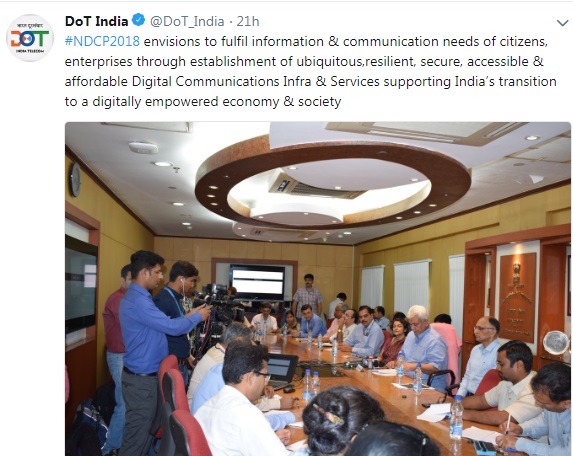The Union Cabinet chaired by Prime Minister Shri Narendra Modi has approved the National Digital Communications Policy-2018 (NDCP-2018) and re-designation of the Telecom Commission as the "Digital Communications Commission”.

(Also read: PM launches Ayushman Bharat, know the key features)
A. Impact:
The NDCP-2018 envisions supporting India's transition to a digitally empowered economy and society by fulfilling the information and communications needs of citizens and enterprises by establishment of a ubiquitous, resilient and affordable digital communications infrastructure and services.
The ‘Customer focused’ and ‘application driven’ NDCP-2018 shall lead to new ideas and innovations, after the launch of advanced technology such as 5G (5th Generation), IoT (Internet of Things), M2M (Machine-to-Machine) communications, etc. which shall govern the telecom sector of India.
(Also read: Agmark online system is being implemented to conduct quality control functions across the country)
B. Objectives:
The key objectives of the policy are:
- Broadband for all
- Creating four million additional jobs in the Digital Communications sector
- Enhancing the contribution of the Digital Communications sector to 8% of India's GDP from 6% in 2017
- Propelling India to the Top 50 Nations in the ICT Development Index of ITU from 134 in 2017
- Enhancing India's contribution to Global Value Chains
- Ensuring Digital Sovereignty.
These objectives are to be achieved by 2022.
(Also read: Ministry of Labour and Employment mandates online filing of registration and licensing applications by employers)
C. Features:
The policy aims to
- Provide universal broadband connectivity at 50 Mbps to every citizen
- Provide 1 Gbps connectivity to all Gram Panchayats by 2020 and 10 Gbps by 2022
- Ensure connectivity to all uncovered areas
- Attract investments of USD 100 billion in the Digital Communications Sector
- Train one million manpower for building New Age Skill
- Expand IoT ecosystem to 5 billion connected devices
- Establish a comprehensive data protection regime for digital communications that safeguards the privacy, autonomy and choice of individuals
- Facilitate India's effective participation in the global digital economy
- Enforce accountability through appropriate institutional mechanisms to assure citizens of safe and secure digital communications infrastructure and services.
(Also read: Finance Ministry Launches Jan Dhan Darshak app as a part of Financial Inclusion)
D. Strategy:
The policy advocates:-
- Establishment of a National Digital Grid by creating a National Fibre Authority;
- Establishing Common Service Ducts and utility corridors in all new city and highway road projects;
- Creating a collaborative institutional mechanism between Centre, States and Local Bodies for Common Rights of Way, standardization of costs and timelines;
- Removal of barriers to approvals; and
- Facilitating development of Open Access Next Generation Networks.
(Also read: No service can be denied even if Aadhaar verification using biometrics fails)
E. Background:
As the present world has entered the era of modern technological advancements in the Telecom Sector such as 5G, loT, M2M etc., a need was being felt to introduce a 'customer focused' and 'application driven' policy for the Indian Telecom Sector, which can form the main pillar of Digital India by addressing emerging opportunities for expanding not only the availability of telecom services but also telecom based services.
(Also read: Ramdev's entry in Dairy segment, Patanjali to sell even milk and divya water)
(Also read: PM announces increase in remuneration for ASHA and Anganwadi workers)
(Also read: Airtel Payments Bank users can withdraw money without any debit card at ATM)
For more updates:
1. Like our Facebook Page
2. Join our Telegram Group
3. Join our Facebook Group
4. Subscribe to our Youtube Channel
5. Follow us on Twitter
6. Follow us on Instagram
Disclaimer: The above post includes some content used from PIB website and executed on this website for fair use only. As this website is of educational nature, hence the content is used for education and awareness to the public.

